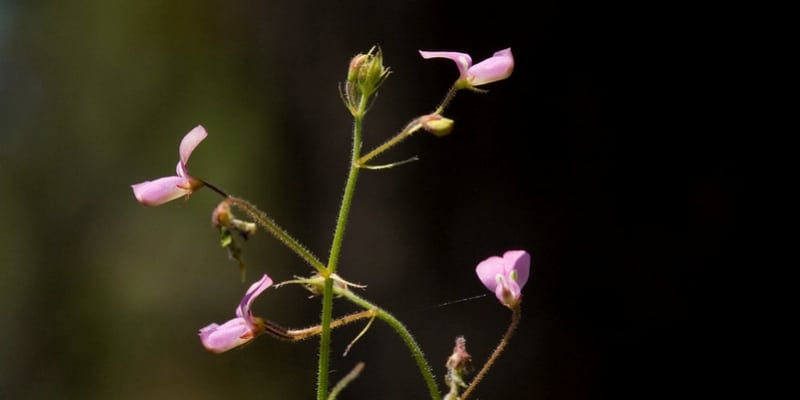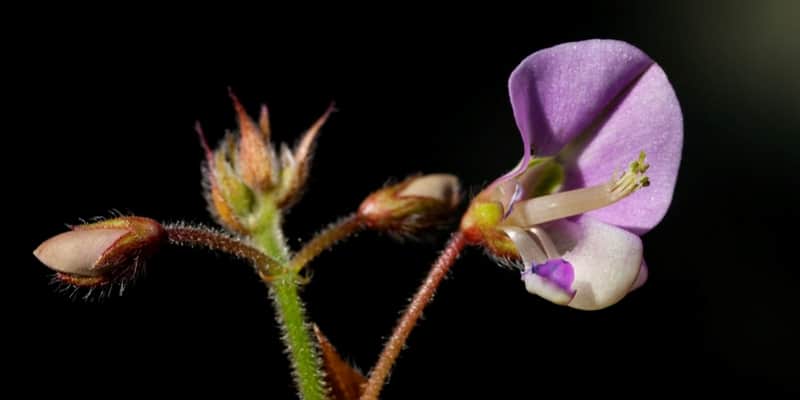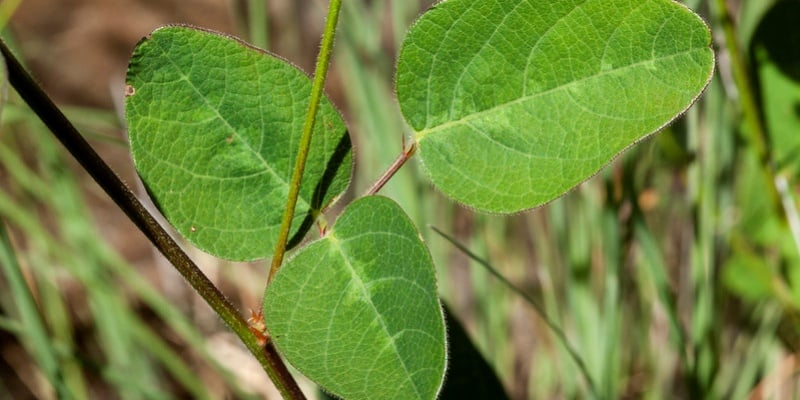Flower Glossary is reader-supported. When you buy through links on our site, we may earn an affiliate commission.
Desmodium is a genus in the Fabaceae family. This plant, often known as tick clover, has many names and uses. You might want to grow some of these, as they can be used in farming. But, they also make good garden plants if you want to add some purplish-pink flowers to your yard!
Unlike some photos might show, this plant won’t always be sizable with big and bright flowers. So how do you know if you’ve come across Desmodium? In this post, we’re going to talk about the different species, their uses, and how to grow this legume!
First, let’s start off with some more general information.

Table of Contents
Desmodium Overview
Desmodiums have many names. Some of the more common ones are tick clover, beggar lice, tick-trefoil, and hitch hikers. These plants are legumes and contribute to habitat and food for wildlife in the areas in which they grow. Hitch hikers tend to be found in a few notable regions – such as Piedmont (Northwest Italy), mountains, and coastal plains.
This herbaceous perennial can grow between 2 to 4 feet tall. Although some varieties can grow fairly large, most tend to be small shrubs or herbs. They can grow as a woody trailing ground cover and will climb if they have the necessary support.
The fruit of a beggar’s lice is a loment or a lomentum. This is a type of fruit that breaks apart in such a way that each segment contains a seed. This means that each seed is individually dispersed in a segment, making them quite hardy plants.
The hairy seeds also spread with ease, as they stick to fur or clothing. This allows animals and humans to be a part of the seed dispersion. The seeds germinate rather enthusiastically after the spreading process. Due to the tenacity of the plants, Desmodiums are considered to be weeds in some places – such as Queensland.
The flowers can differ in color and might be white or violet. The leaves are fairly distinct, being alternate and trifoliate with hooked hairs growing underneath. When it comes to fire risk, these plants have fairly low flammability ratings. They are also drought-resistant.

Different Species of Desmodium
There are many, many species of Desmodiums. This is the largest genus of plants in the Fabaceae family. Desmodiums are in the subfamily Faboidae and the order Fabales.
Although we could go through each and every species with you, there are currently about 199. From the Desmodium acanthocladum to the Desmodium varians, each species is unique.
Uses of Desmodium
As legumes, these plants fix nitrogen in the soil. This makes them good to grow between crops or as an ‘intercrop’. Trick-trefoil can be used as living mulch and as green manure. Living mulch is a crop that is undersown with another, for reasons such as weed suppression or soil temperature regulation.
If you use Desmodiums as intercrops between something like corn, they can stop weeds from growing. On a farm with livestock, tick clover can make for nutritious foraging material! Green manure would entail tick clovers being left (sown or uprooted) on top of the soil so that they can be incorporated back into the earth after they wither.
However, if you want to grow these herby perennials at home, these reasons might not catch your attention. There are more uses to Desmodiums that are applicable to home gardening. This is where the aesthetics of the legumes come in!
As these plants can have big, bright flowers, they can make for a pretty addition to your garden. They tend to flower in late Summer and can produce flowers in a variety of colors. However, when they are not flowering, they can make for stunning climbing vines or ground cover.
Depending on the variety, the leaf colors might differ. But, no matter the color, they can be a beautiful element in your garden. These plants also attract pollinators, small mammals, butterflies, and songbirds. If you love your garden buzzing, get planting!
How To Grow Desmodium
Desmodiums are not hard to grow, as they are such a hardy plant. You can grow them in many conditions! They are happy in either sunlight or shade, so long as the soil has relatively good drainage. This means that the soil should be moist to dry.
Water
As we mentioned earlier, these plants are drought resistant. This means that they don’t need constant attention. Water them until they seem somewhat established and then give them their space. In terms of fertilizer, these plants don’t need much. They tend to grow fast and can become weedy, so there generally isn’t a need to give them fertilizer for home planting.
Planting
If you are growing Desmodiums for farms versus for your home, the method will differ. But, if you’re planting from seed, make a 1-inch deep hole, and drop the seed in. You can mix it with fertilizer if planting for a farm, although, as we said, it isn’t necessary for your personal garden.
You can also grow Desmodiums from cuttings. So, if you know someone with tick clover, you can start your own plant! The plant is compatible with tussock grasses and will climb over shrubs if they are in close proximity to the plant.
Pests
In terms of pests, Australia and Central America have seen their Desmodiums challenged. Various strands in Australia were attacked by a root-eating weevil. In conditions with high rainfall, such as Central America, strands were affected by leaf fungus.
Other than that, Desmodium varieties are generally strong and unproblematic.
Final Thoughts
Desmodiums are unique plants that are useful in farming and can be lovely additions to your home garden. Given that they are such hardy plants, they can grow in a number of conditions! These plants can vary in flower and leaf color, depending on the species.
There are many species of Desmodium and each is unique in some aspect. These tick clovers have many names and uses. So, if you love low-maintenance plants with pretty flowers, start planting some Desmodium!
